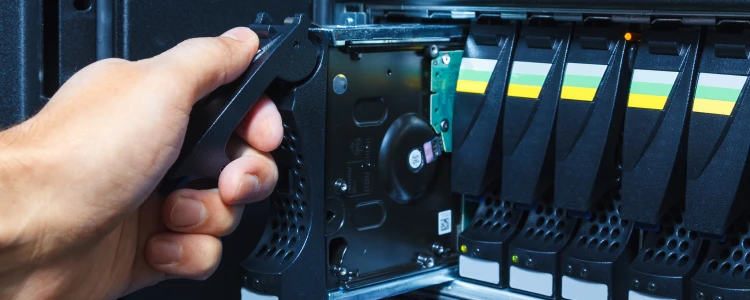Software RAID vs Hardware RAID – What are the Differences?

Software RAIDs can struggle with performance, especially with NVMe drives. On the flip side, hardware RAIDs generally offer better performance and access speeds due to their dedicated processing power.
At ServerMania, our fully optimized RAID infrastructure ensures the safety of your data. As a leading cloud hosting company, we specialize in building large storage servers. With over two decades of experience, we’ve protected our clients against malware, ransomware, and security risks. Browse ServerMania’s dedicated servers today to see how we can help.
Organizations, now more than ever, have been adding software-based components to their storage infrastructure. RAID is part of this storage infrastructure as it optimizes storage capacity and lowers the risk of data loss. Today, software RAIDs are replacing hardware RAIDs in many IT infrastructures. The major difference between hardware RAID and software RAID is that access to the hardware RAID is managed by controllers separate from the operating and file system itself, while the software RAID is managed by software within the operating system. Their prices, performances, and access speeds all differ.
RAID is a virtual storage resource that connects one or more computer devices to an array of multiple storage devices under controller management. When users apply a RAID system, they see the disks as logical storage resources. There are a lot of possibilities for RAID storage, and the prices vary just as much as the range of devices and controllers offered.
What is RAID?
RAID stands for Redundant Array of Independent Disks and uses multiple hard drives to make redundant data copies. If a drive in a RAID array fails, the data remains secure through various mechanisms. RAID virtualizes multiple independent hard drives or disks into one or more arrays to increase performance, capacity, and fault tolerance across different operating systems. It can be performed via hardware or software. For more detailed information, check out our blog on everything you should know about RAID Arrays, Levels, Storage, and Servers.

Comparison – Software RAID vs Hardware RAID
RAID can be executed either using a special hardware controller (Hardware RAID) or an operating system driver (Software RAID).
Software RAID
Software RAID implements RAID without dedicated hardware components, with the host computer managing the physical drives. The disk controller software is embedded within the computer system and must be compatible with the OS. Multiple physical disks are grouped to form an array. If storage drives are connected to a server or computer without a dedicated hardware RAID card or controller, the RAID configuration is handled by utility software integrated within the operating system. This setup is referred to as software RAID.
Software RAID allows users to change the disk array and requires more user interaction with the server and operating system, as the RAID controller is part of the OS. The cost is low because no additional hardware RAID controller is needed. The software layer performs RAID functions, including data striping, mirroring, or parity calculations. Many operating systems support software RAID configuration, including those from Microsoft, Apple, various Linux distributions, Solaris Unix, FreeBSD, OpenBSD, and NetBSD.
Benefits of Software RAID
- Software RAID is more economical than hardware RAID, as it eliminates the need for additional RAID controller hardware and utilizes existing CPU resources.
- Implementing software RAID is straightforward as it integrates directly with the host OS, requiring no proprietary hardware or vendor-specific solutions.
- Software RAID typically offers greater flexibility with supported RAID levels and additional settings.
Drawbacks of Software RAID
- Software RAID relies on the host CPU for I/O operations, potentially impacting overall system performance, especially under heavy I/O loads, particularly with solid-state drives (SSDs).
- High CPU usage can potentially affect the performance and availability of the entire RAID array.
- Software RAID configurations are tied to the specific operating system they are set up on. When upgrading or changing operating systems, users may encounter challenges with compatibility or data migration.
Hardware RAID
When the RAID controller first hit the market, it was initially configured using hardware. This setup allows you to link the RAID controller to one or more computers and multiple storage devices in the disk array, configuring all RAID-related components to their specific RAID level according to your organization’s requirements. Disk arrays and controllers can be modified separately from computing equipment.
Hardware RAID is a specialized processing system designed to handle RAID configurations independently of the operating system. It uses several RAID cards, ensuring that the managed disks are not significantly deprived of processing power. The dedicated RAID card also manages the disks in a way that makes the host computer’s processes essentially transparent. This approach offers a greater variety of RAID design options, including hybrid setups that might not be compatible with all OS options. However, hardware RAID is expensive and significantly raises the overall cost of setting up a RAID, which is why most organizations opt for a software RAID setup.
Benefits of Hardware RAID
- Accessing data with hardware RAID is typically faster.
- The controller operates independently of the associated computer, managing disks without using the computer’s processing power.
- Replacing a downed disk by removing and replacing the device is easy.
- Hardware RAID cards are generally immune to cyber-attacks since the RAID system operates independently from the host OS. Modern hardware RAID controllers now include hardware-based encryption mechanisms to secure data on the drives.
Drawbacks of Hardware RAID
- Although hardware RAID is often more reliable since it does not take processing power away from the disks, it can be more expensive than software RAID.
- It may not be compatible with the associated OS.
- While hardware RAID controllers can enhance performance, the controller’s capabilities limit the optimization level.
- Unlike software RAID, which can be managed using familiar operating system tools, hardware RAID typically requires specialized knowledge to configure and monitor with proprietary RAID management software.

RAID Controllers and Implementations
Hardware RAID Controllers
Hardware RAID controllers implement RAID protocols and are available from several manufacturers. SATA drives have lower performance, latency, and scaling requirements, making hardware and software RAID logic integration easier. Hardware RAID works with Serial Attached SCSI (SAS) controllers, but NVMe RAID implementation is limited and may struggle with performance.
Software RAID Implementations
Software RAID or volume managers can improve the flexibility of storage allocation on a server, adding critical data, reliability, and performance features. Software RAID implementations range from simple abstraction products to larger and more feature-rich volume manager products. The main strength of software RAID is flexibility, but it may struggle with performance, especially with NVMe drives.

Raw Capacity vs Usable Capacity
When using RAID, it’s important to understand that the raw capacity of your drives differs from the usable capacity available for storing data. Raw Capacity refers to the total storage capacity of a drive. For example, with three 500GB drives, the total raw capacity of three drives in the backup system is 1,500 GB.
On the flip side, Usable Capacity is the amount of space available for data storage after RAID configuration and formatting. RAID levels significantly impact usable capacity on most systems by sacrificing about 30% to 40% of storage space for redundancy, resulting in approximately 60% to 70% usable capacity.
Well, not only RAID configurations but also drive formatting reduces usable space. Typically, about 10% of your hard drive’s storage is reserved for formatting by the manufacturer and the operating system. Therefore, from three disks totaling 1,500GB raw capacity, after RAID configuration and formatting, you might expect around 800GB of usable capacity for storing data.
Common RAID Configurations
- RAID 0 (Striping) – increases performance, but at the cost of data loss if one of the drives fails.
- RAID 1 (Mirroring) – saves data if a single drive in an array fails.
- RAID 5 (Striping with Parity) – uses RAID parity to protect data while providing a performance boost.
- RAID 6 (Striping with Double Parity) – similar to RAID 5, but requires a minimum of four hard drives.
- RAID 10 (Combines RAID 1 & RAID 0) – provides security by stripping data across each set of drives and mirroring the data on the second set of drives during power failure.

RAID Scalability and Fault Tolerance
Scalability Considerations
Hardware RAID is generally more scalable than software RAID. Although software RAID can be a cost-effective option, it may not provide the same level of performance and scalability as hardware RAID.
Fault Tolerance and Redundancy
RAID provides primary storage and secondary support for applications, files, and databases. Adding more drives to the array increases storage capacity, write performance and fault tolerance. RAID is important to an organization’s data protection and disaster recovery strategies.
Wrap Up
When comparing hardware RAID and windows software RAID and configurations, software RAID setups are less efficient and have more limitations. On the other hand, software RAID is less expensive and lets you change the hardware and software RAID array configuration without worrying about controller compatibility. Software RAID is best if you’re on a tight budget, but hardware RAID is better if performance is important to you. You should always keep RAID data recovery software available in case something goes wrong so you can swiftly recover from your RAIDs.
Book a free consultation with us today to speak with our of our experts about your RAID configuration options.
Was this page helpful?

